
Sky-savvy Farming: Building Resilience in an Ever-changing Climate
Nobody wants drought, but it's been happening a lot in recent years in the Southeastern U.S. For farmers without irrigation, it may seem that little can be done besides accept what rain comes. However, by paying attention to forecasts and following general practices that help collect and retain moisture, risk can be reduced for all manner of future climate conditions. Here are some ideas for what can be done, centered around two practices: first, knowing what's in store; second, planning ahead.
First, know what's in store
You'll find resources and examples in the first section below to help assess current conditions and learn about predictions for the future.
Second, plan ahead
The second section gives you ideas for how to use this information to plan for the coming months while building long-term resilience to moisture extremes.
I. Assessing Drought in the Southeastern United States
NOTE: The maps provided here are used as examples only. Visit the website provided with each map to see the most recent version.
Current Conditions
The best way to be familiar with the situation on your farm is, of course, to visit your fields regularly and observe crop conditions and moisture levels below the surface. There is enormous variation within regions, states, counties, farms and even individual fields because of soil type, cropping history, localized storms, etc. Summaries of recent weather events in your area and short-term forecasts are available from media sources such as TV, radio, newspapers and the Internet.
- AEMN, the Automated Environmental Monitoring Network (http://www.georgiaweather.net), records air and soil temperature, humidity, precipitation, wind speed and more than 20 other variables every 15 minutes at 80 stations around Georgia.
- The National Weather Service (https://www.weather.gov) provides current information and forecasts for the next few days for select locations around the state.
Because drought develops over long periods of time, and likewise takes more than a rain or two to alleviate, some of the day-to-day variation is less important. The best resource for accurate drought information is the U.S. Drought Monitor (https://droughtmonitor.unl.edu/), which is updated weekly by the University of Nebraska. This resource provides an overall map of the U.S. showing categories of drought and includes a written description of conditions by region. If you click on the Southeast, and then on Georgia, you will see a map that looks like this:

Here you can determine where your county stands and, by looking at the table, see how things have changed in the state over the past year. The map uses colors to represent standard drought categories. For example, white shows those regions with sufficient moisture, and yellow ("D0, Abnormally Dry") indicates an area that is on its way into or out of a drought situation. The accompanying table shows the history of drought for the entire state. For example, on this map, the total area in exceptional drought (right-most column) has stayed the same over the past 3 months at around 20%, while the area under severe drought (orange column) decreased by almost 25% over the same period.
Other resources for current drought-related information include:
- Drought Impact Reporter (https://droughtreporter.unl.edu/map/) compiles local and specific instances of impacts due to drought. On the U.S. map, click on Georgia (or any state) to see the current reports. You can also contribute information from your own farm.
- Streamflow data is available at https://waterwatch.usgs.gov/new/index.php?id=ww_current, which shows the current day compared to historical values.
- Current well measurements compared to historical values are available from the U.S. Geological Survey at https://waterdata.usgs.gov/nwis/gw.
- Soil moisture information, including deviations from normal, can be found at https://www.cpc.ncep.noaa.gov/ products/Soilmst_Monitoring/US/Soilmst/Soilmst.shtml
- The inches of rainfall needed to alleviate drought is estimated at https://www.cpc.ncep.noaa.gov/products/analysis_monitoring/regional_monitoring/addpcp.gif.
- Additional sources of climate information may be obtained from your local Cooperative Extension office and other agencies such as the Georgia Forestry Commission (https://weather.gfc.state.ga.us/climate/climate.aspx) and the State Climatology Office at the Georgia Environmental Protection Division (https://epd.georgia.gov/about-us/contact-us/office-state-climatologist).
Outlook: The Coming Weeks
The Climate Prediction Center at NOAA provides precipitation and temperature outlooks for the coming 6 to 10 days, 8 to 14 days, 1 month and 3 months at https://www.cpc.ncep.noaa.gov/. An example of a 3-month precipitation outlook map from late January 2012 looks like this:

These maps give a rough idea of whether we expect to get a greater or lesser total volume of precipitation than the historical averages. The amount of precipitation anticipated is presented in three broad categories: above normal (A), normal (N) and below normal (B). The map is white and labeled "EC" if there's an equal chance (33%) of these three situations occurring. Color bands are shown if there is more than a 33% probability of above normal (green) or below normal (brown) rainfall. The colors become darker with increasing probability, with percentages given at the color boundaries.
For example, on this map north Georgia (white with "EC") has an equal chance of above normal, normal or below normal precipitation; central Georgia (light brown) has a probability (33 to 40%) of below normal rain; and south Georgia (darker brown) has a higher likelihood (40 to 50%) of below normal rain. South Florida has a greater than 50% chance of below normal precipitation. If there is more than a 33% chance of normal rainfall, the map is white but labeled "N" instead of "EC," as shown for Alaska. This can be confusing, so be aware that N means that normal conditions are likely, EC means that normal conditions are no more likely than below or above normal — essentially, we can't predict what's coming. Also note that this says nothing about how much more or less rain might fall.
NOAA's prediction of future drought conditions is available by clicking on the U.S. Drought Assessment—Drought Outlook link at the same site, or by visiting https://www.cpc.ncep.noaa.gov/products/expert_assessment/season_ drought.gif for a map like the one shown below, which is revised at approximately 2-week intervals.
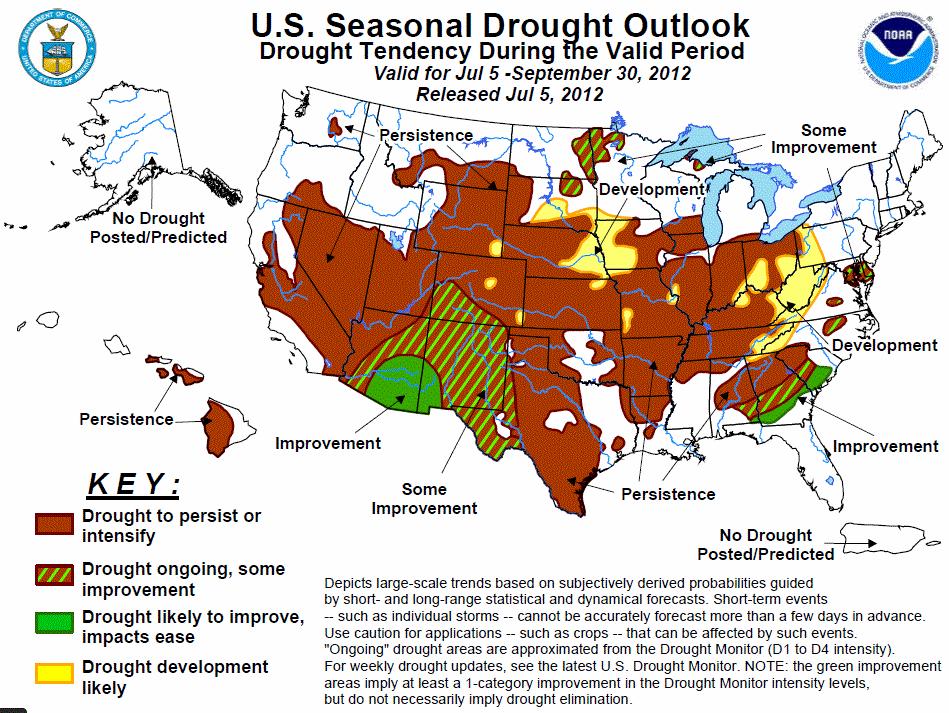
This example, also from January 2012, indicates that the northern half of Georgia should expect the drought to continue and perhaps get worse (solid brown color), with "some improvement" (hatched brown) or "improvement" (green) occurring in the central bands. The white region in the southeast part of the state has not been affected so far, and no development of drought is foreseen.
Outlook: The Coming Months
In Georgia we can sometimes predict winter and early spring conditions many months in advance because we are responsive to the El Niño Southern Oscillation (ENSO) phenomenon. ENSO primarily describes sea surface temperatures in the equatorial Pacific Ocean, which can affect weather globally. When the central and eastern Pacific becomes unusually warm, we have an El Niño situation, which means cool, wet conditions in the Southeast U.S. in winter and spring. When the Pacific is abnormally cool, we get what is known as La Niña, which brings warm and dry weather to the Southeast during this period. The maps below show this trend for precipitation. In Map A, which illustrates rainfall trends in El Niño winters, green shades in south Georgia correspond with rainfall 30-50 mm above normal (indicated in the bar below the maps). The La Niña winter pattern is shown in Map B, where violet and orange colors correspond with various levels of reduced rainfall.
| A. Rainfall changes in El Niño winters | B. Rainfall changes in La Niña winters |
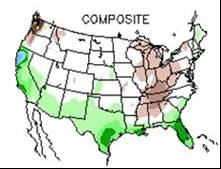 |
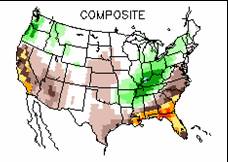 |
 |
|
| Difference from normal rainfall, in millimeters | |
El Niño conditions have occurred in about 25% of the years for which we have records. The same is true for La Niña. When neither occurs, it is called a "neutral" condition. This has been the case in the remaining half of observed years. Although there is no clear pattern to El Niño or La Niña occurrences from year to year, the current phase of the ENSO cycle and predictions for the near future may be found at the top of the AgroClimate homepage at http://agroclimate.org.
An El Niño, La Niña or neutral condition that develops in the summer in the Pacific Ocean typically persists through the winter and has predictable effects on Georgia's weather well into spring. This makes it possible to plan for likely drought-related developments. Any water deposited on the ground in the winter that does not run off or percolate into the groundwater will recharge the soil and can only be removed by evaporation or transpiring plants. Low temperatures and dormant plants in winter minimize this loss, so winter precipitation has a profound impact on the following growing season. If a dry winter (La Niña) or a wet winter (El Niño) is likely, this recharge will be altered accordingly.
Outlook: The Coming Years
There is a consensus among climatologists that temperatures have been rising globally since the Industrial Revolution and will continue to rise substantially over the next century. Predictions indicate there will be changes in precipitation, with some regions becoming drier while others become wetter, in addition to a general increased likelihood of extreme weather events such as floods, hurricanes and drought. A summary of current predictions can be found in the synthesis report of the last Intergovernmental Panel on Climate Change (IPCC) assessment at https://www.ipcc.ch/assessment-report/ar6/.
These are general expectations and will vary greatly by region. In Georgia, warming has been minimal over the last 30 years, perhaps due to other factors like land use change. Nonetheless, temperatures are expected to climb over the next several decades, resulting in more summer days with extreme heat. Although current models do not adequately predict changes in precipitation, the most important factor in drought, the ability of climatologists to predict outcomes at more regional and local levels improves every year, as does the understanding of the ways these outcomes interact with land use and other phenomena like ENSO.
In the meantime, the best bet for farmers is to do what works in the short term as well: build resilience. Whatever practices can be undertaken to maintain and improve productivity through a wide range of climate variation, including drought, will always be of benefit.
II. Using the Outlook for Decision-making
Near-term Choices
Farmers who do not irrigate can use current weather forecasts from sources like the radio, TV, newspaper, the National Weather Service (www.weather.gov) or Weather Underground (www.wunderground.com) to help make day-to-day decisions about planting, cultivating, spraying, cutting hay, etc. But what if the climate outlook for the coming months predicts little rainfall or a La Niña winter, which means the next season is likely to start with a moisture deficit? There are choices you can make that reduce your vulnerability to loss.
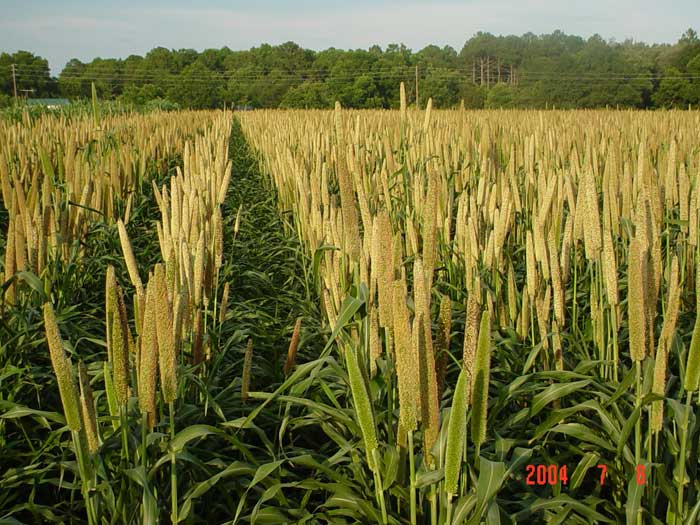 Pearl millet in flowering stage.
Pearl millet in flowering stage.- Crop and cultivar selection. Instead of planting a demanding crop like corn, you might opt for a low-moisture alternative such as grain sorghum or pearl millet. Within a crop species, there may be cultivars that are less sensitive to moisture stress. Among vegetables, for example, short-season varieties generally require less water. Note that nitrogen-fixing bacteria, which occur in legumes and make them a great source of fertility, are particularly susceptible to low moisture. Check with your Extension agent about the best choices for your location.
- Cropping system. Avoiding bare, exposed soil will help conserve moisture. This can be accomplished between seasons with cover crops, and the choice of crop makes a difference. Grasses like rye, triticale and wheat work better for water conservation than legume covers. Be sure to terminate the cover crop 3 to 4 weeks before planting to reduce water depletion. During the growing season, mulch will reduce evaporation and erosion, and help absorb precipitation. Plastic mulch with a white surface will improve water conservation and avoid heat accumulation better than black or clear mulch, but organic mulches such as straw are less expensive and will add organic matter to the soil and improve water-holding capacity. Conservation tillage also aids in preserving precious water. Using transplants rather than direct seeding reduces the risk of a poor stand. Also adjust fertilization — a crop that is water-limited will not respond well to added nutrients.
- Livestock and forage practices. Drought creates unique problems like nitrate and salt toxicity for livestock producers; however, these producers have some flexibility in altering stocking rates, buying feed, reducing nutritional needs of animals and culling, if necessary. Cover crops may be used as forage. Farmers may benefit from consulting publications such as Forage Use and Grazing Herd Management during a Drought (UGA Cooperative Extension Circular 914) or Mississippi Beef Cattle Producer Guide to Coping with Drought Conditions (Pub. p2426, Mississippi State University). Heat stress is often associated with drought and impacts may be immediate in dairy operations. When the dry, warm conditions of a La Niña winter and spring are predicted, a producer can minimize risk by reducing herd size or arranging to have winter feed ahead of time. Seeding pastures or applying fertilizer may be avoided since response is likely to be poor without rain. A number of practices are recommended for La Niña conditions at agroclimate.org; click on the "Forage & Livestock" link.
- Diseases and pests. An up-side of dry conditions is that diseases tend to develop poorly or not at all, which may allow producers to reduce or eliminate sprays and save money, or consider planting cultivars they might avoid when disease is likely. However, a few diseases do fare better when things are hot and dry, such as white mold of peanuts and soybeans (caused by Sclerotium rolfsii), bot rot of apples, and many powdery mildews. It is important to be familiar with your crop and its likely diseases. Insect and other arthropod pests, on the other hand, often do well in dry conditions, sometimes because natural enemies are less effective at controlling them. Fall armyworms, spider mites, aphids and thrips (which carry the Tomato Spotted Wilt Virus) are among the many pests favored when rainfall is low and temperature is high. Be aware of indirect problems in drought conditions as well: the fungus Aspergillus does well and produces the toxic aflatoxin chemicals in corn and peanuts, seriously degrading quality. Clearly, there is no single prescription for pests and diseases under drought, so each grower must become familiar with his likely problems, consult with Extension agents and publications, and plan accordingly.
Note: Pumpkin and winter squash vines may wither in drought before the fruit is completely mature. Harvesting at this time makes rot more likely in storage.
- Matters of scale. Not only might livestock producers reduce herd size or stocking rates, but produce or crop farmers might opt to scale back operations by leasing less land or minimizing the acreage of risky or high-water-use crops. New enterprises such as agritourism or adding value through processing, as well as new markets, might also be considered.
Long-term Choices
- Diverse and adaptable cropping strategies. As the adage goes, "Don't put all your eggs in one basket." By growing a diversity of crops, farmers can hedge their bets so that poor performance or even failure of one drought-intolerant species does not ruin the entire year. The same can be said for diversifying cultivars if you do tend to specialize in one or a few crops. Flexible rotations and adaptable equipment allow you to alter plans when the rainfall outlook is poor or a dry La Niña winter occurs. Cooperation with neighbors or borrowing/ leasing of equipment and land can maximize flexibility at the lowest cost.
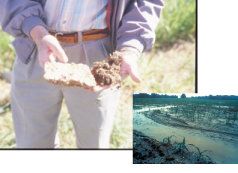 Soil under conservation tillage (above) had lots of organic matter and trapped rain instead of allowing excessive runoff (inset).
Soil under conservation tillage (above) had lots of organic matter and trapped rain instead of allowing excessive runoff (inset).- Soil quality improvement. Increasing the water-collecting and water-holding capacity of soil, coupled with good drainage, provides enormous benefits both during droughts and when rains finally come. There are three important ways to do this:
- Add organic matter. A 1% increase in soil organic matter can increase available water capacity 1.5 times.
- Keep the soil covered. Bare soil allows rain to run off, while vegetation traps it long enough to enter the soil. In one study in north Georgia, 16% of annual rainfall was lost from a conventional field, compared to only 2% in an adjacent no-till field. Remember that when water runs off, topsoil and nutrients are lost as well!
- Avoid soil compaction. Many Southeastern soils have a hardpan at a depth of 6 to 9 in. that effectively prevents penetration of rain or roots below this level. Eliminating this layer and avoiding further compaction will help retain water and encourage deep root growth, a great benefit in times of drought.
Planting cover crops (especially deep-rooted ones) and taking care to work the soil only when conditions are good will build soil organic matter, break up the hardpan, avoid compaction and allow the soil to retain more moisture each year. Difficult hardpans can be eliminated with a ripper or subsoiler. Using the sod-based rotation described below, conservation tillage, or your own system that includes these elements all build soil quality, which has benefits beyond just drought relief, including better nutrient retention, reduced disease and weeds, and greater yields overall.
- Sod-based rotation. The University of Florida has developed a 4-year rotation with cotton, peanuts and 2 years of grass that can be harvested as hay or by grazing. This sod-based rotation (SBR) greatly improves water retention. Reduced water, fertilizer, pesticide and fuel use has resulted in as much as a doubling of cotton and peanut yields in trials in three states. Learn more at https://sodbasedrotation.com/
Drought will occur in the future as it has in the past, and the changing climate will present additional challenges that are difficult to predict. Becoming familiar with the resources presented in this publication will help you be aware of what's in store and allow you to plan ahead for drought. It's all about building resilience to minimize risk and maximize profit on your rain-fed farm.
Status and Revision History
Published on Jul 31, 2012
Published with Minor Revisions on Mar 21, 2017
Published with Full Review on Oct 14, 2024
